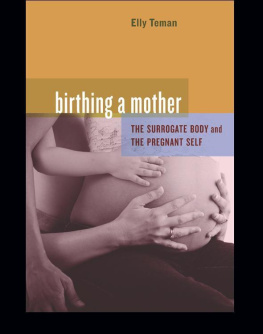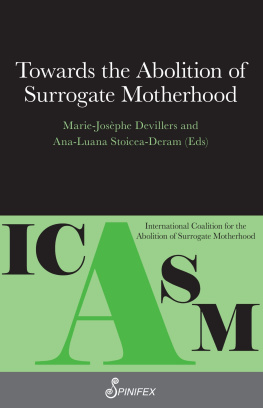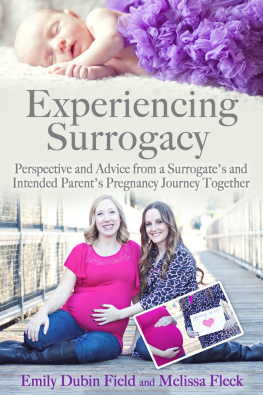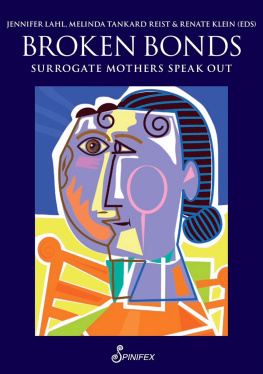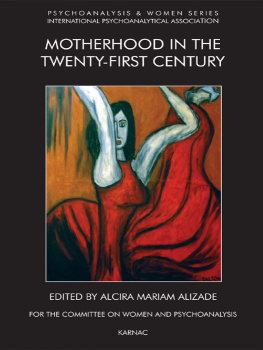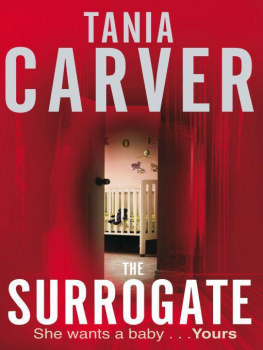Birthing a Mother
The Surrogate Body and the Pregnant Self
Elly Teman

UNIVERSITY OF CALIFORNIA PRESS
Berkeley Los Angeles London
University of California Press, one of the most distinguished university presses in the United States, enriches lives around the world by advancing scholarship in the humanities, social sciences, and natural sciences. Its activities are supported by the UC Press Foundation and by philanthropic contributions from individuals and institutions. For more information, visit www.ucpress.edu . University of California Press
Berkeley and Los Angeles, California University of California Press, Ltd.
London, England 2010 by Elly Teman Library of Congress Cataloging-in-Publication Data Teman, Elly.
Birthing a mother : the surrogate body and the pregnant self / Elly Teman.
p. cm.
Includes bibliographical references and index.
ISBN 978-0-520-25963-8 (cloth : alk. paper)
ISBN 978-0-520-25964-5 (pbk. : alk. paper)
1. Surrogate mothersIsrael. 2. MothersIsrael.
3. PregnancyIsrael. 4. Judaism. I. Title.
HQ759.5.T46 2010
306.8743dc22 2009019426 Manufactured in the United States of America 19 18 17 16 15 14 13 12 11 10
10 9 8 7 6 5 4 3 2 1 This book is printed on Cascades Enviro 100, a 100% post-consumer waste, recycled, de-inked fiber. FSC recycled certified and processed chlorine free. It is acid free, Ecologo certified, and manufactured by BioGas energy.
This book is dedicated to my one-of-a-kind mother, Rhisa Teman adoptive mother to many generations of students, but the only mother for me. And it is dedicated to the memory of my beautiful grandmother, Ruth Ellen Erlich, whom we knew as Sasi.
And thats why I say, I didnt just give birth to a baby, I gave birth to a mother. Tamar, surrogate I always say, my mother gave birth to me the first time, she gave me life. But my surrogate gave me life the second time. Shlomit, intended mother You are not just giving birth to children; you are giving birth to new mothers and to new and happy families. Mali, intended mother Let your Mother and Father be glad; let she who bore you rejoice. Proverbs 23:25
Contents
Illustrations
| 1. | Surrogate attached to an incubator | 33 |
| 2. | Surrogate holding a flowerpot for the couples sapling | 34 |
| 3. | Mug depicting an oven and the popular slogan Their bun, my oven | 35 |
| 4. | Surrogates body map | 55 |
| 5. | Surrogate as an innkeeper hosting a family in her womb | 59 |
| 6. | Surrogate and intended mother sharing the pregnancy | 144 |
| 7. | Surrogate and intended mother sharing a belly | 160 |
| 8. | Surrogate and intended mother in a suffocating relationship | 167 |
| 9. | Surrogate as Superwoman | 242 |
| 10. | Surrogate as Israeli national heroine | 256 |
| 11. | Surrogate as pregnant fairy or angel | 269 |
| 12. | Surrogate being dressed in an angel costume | 272 |
Acknowledgments This book could never have come to completion without generous funding from various sources. Fieldwork and early writing of the manuscript were enabled by generous scholarships from the Canadian Friends of the Hebrew University, the Golda Meir Foundation, and the Social Sciences Faculty Rectors Prize of the Hebrew University. I also thank the Hadassah Brandeis Institute, the Israeli Association of Academic Women, and the Lafer Center for Gender Studies for research awards in support of this project. Postdoctoral fellowships from the Yad Hanadiv-Rothschild Foundation and from the Morris Ginsberg Foundation enabled me to spend a full academic year at the University of California, Berkeley, to further my training and to complete this book. The Beatrice M. Bain Research Group and the Science, Technology, and Society Center at UC Berkeley gave me a stimulating intellectual environment in which to write. This book came to completion while I was a postdoctoral research scholar at the Penn Center for the Integration of Healthcare Technologies (Penn CIGHT) at the University of Pennsylvania. I am grateful to the center and its staff for supporting my completion of this project.A number of articles based on this research have been published in journals and in edited volumes. Part of the prologue appeared in 2006 in Gardner and Hoffmans Dispatches from the Field: Neophyte Ethnographers in a Changing World (Long Grove, IL: Waveland Press). Part of part 1 appeared in 2001 in Womens Studies Quarterly 31 (3&4): 1134 and in 2003 in Medical Anthropology Quarterly 17 (1): 7898. Part of part 2 appeared in 2003 in a chapter in Cook, Sclater, and Kaganass Surrogate Motherhood: International Perspectives (Oxford, UK: Hart Publishing, pp. 261280) and is forthcoming in Body and Society 15 (3). Finally, part of the conclusion was published in Social Science & Medicine 67 (7): 11041112. I am grateful to the editors and anonymous reviewers of these publications for their suggestions and feedback. The illustrations in this book have been reproduced with the generous permissions of the following Israeli illustrators: Ruth Gwily, Gila Kaplan, Rutu Modan, Naama Peleg-Segal, David Polonsky, Danna Shamir, and Rhisa Teman.Over the years, a number of scholars have provided invaluable guidance and support. I especially want to thank Eyal Ben-Ari, my dissertation advisor. He has an unmatchable ability to take the jumble of theory, ethnography, and random thoughts presented to him and help one shape it into a coherent outline. I am grateful for this opportunity to formally acknowledge his peerless mentorship. Meira Weiss has been an important mentor from the time I began my M. A. studies at Hebrew University. Meiras continuous support and encouragement during my fieldwork and her influential perspective on the anthropology of the body are in evidence throughout my work. She encouraged me to publish my work even at its early stages and introduced me to some of the top scholars in my field; to me, this exemplifies feminist mentorship in its truest form.During the course of this project at Hebrew University, I had the good fortune to receive guidance from several people who informally included me as one of their own mentees. Don Seeman helped me formulate my very first thoughts on surrogacy as my final paper in the medical anthropology course he taught; his close readings and comments on various drafts of this manuscript were important to my thinking throughout this project. Tamar Rapoport and Edna Lomsky-Feder generously included me in a reading and research group they mentored for several years with their graduate students. I learned valuable lessons about theory and critical analysis from them and benefited greatly from the support and comments on my writing from the members of the group.My fellow graduate students and the faculty of the department of sociology and anthropology at Hebrew University provided a collegial network during this research. I especially want to thank those who closely read various chapters or drafts of this study, many of whom are also good friends: Svetta Roberman, Lydia Ginzberg, Adi Kuntsman, Limor Darash, Michal Lester, Lauren Erdreich, Omi Leisner, Tali Berner, Tzvia Birman, Danny Kaplan, Tamar El-Or, Nurit Stadler, and Daphna Birenbaum-Carmeli. I am especially grateful to Noa Aploig for reading through the full manuscript. Tsipy Ivry and I were midwives of one anothers studies; in the lonely world of the via doctoroza, it is rare that one finds co-mentorship like ours. I hope that people will read our books in tandem for what they reveal about the anthropology of pregnancy.Several North American scholars have been extremely helpful to me and my work. This book would never have come to fruition without the unwavering enthusiasm, guidance, and belief in me shown by the amazing Robbie Davis-Floyd. The influence of her path-breaking scholarship in the anthropology of reproduction is central to the conceptual toolkit used in this analysis. Meeting Susan Martha Kahn through our mutual interest in reproductive technologies in Israel has been one of the greatest perks of this project. She has been an inspiration to me with her scholarship, a wise guide in this study, and a great friend. Charis Thompson was the kindest host a postdoc in a strange land could ask for. Her input into my thinking about reproductive technologies and her comments on this book have been invaluable. Diane L. Wolf read through several drafts of these pages and offered important comments and encouragement. She encouraged me to go out on a limb with the conclusion, and I hope that my efforts follow her call. Heather Paxson, Michelle Pridmore-Brown and D. Kelly Weisberg also gave detailed and crucial comments on the full manuscript. A writing group at Berkeley, including Kalindi Vora, Neda Antonosky, and Kimberly Tallbear provided a great support system as well. Special thanks to Susan Markens and Simon Bronner for important advice along this journey. The amazing editing work of Linda Forman is evident throughout this manuscript; her work impressed me so much it led me to seek her out five years after working with her on a journal article. I am also grateful to Tzipporah Avraham and Jennifer Morgan for their edits on other versions of the manuscript. Heartfelt thanks to Stan Holwitz, my editor at UC Press, for giving my book a chance and for his true kindness. I also thank the production staff at UC Press, especially Caroline Knapp and Nick Arrivo.Many friends and family are also present behind the scenes of the fieldwork and writing experiences out of which this dissertation grew. My husband Avi Solomon read through many drafts and made incisive comments and editorial corrections. He has always believed in me more than I did in myself, with patience, grace and love. My parents, Rhisa and Nissan Teman, have been the greatest support team I could ask for, holding my hand in times of crisis and celebrating my achievements; my mom also spent many hours editing my grammar and babysitting my children so I could finish this book, while my dad helped me search for the artists whose work is included in these pages. My godfather David B. Sherman read and commented on papers and drafts, hosted me on my way to conferences, and kept me updated with carefully collected news clippings on important news relevant to my research. He and Roberto Benitez bought me my first business suit for my first international anthropology conference. I am also grateful for the love and support of my beloved grandparents, Ruth (in blessed memory) and Robert Erlich; my brother Adi Teman; and my aunts, uncles, in-laws, and cousins. My aunt Barbara Erlich was especially supportive of my efforts towards this book. My precious children, Uriel Moshe Solomon and Rachela Tilly Solomon, have brought us all so much joy and awarded me an insiders perspective on becoming a mother. And I could not have made it through the years of this research without other good friends not mentioned above, among them Danna Harari, Liat Ventura, Naama Shay-Catrieli, Rinat Zohar Menachem, Itsik Nachum, Helene Goldberg, Lisa Carlsson, Gretty Shweizer, and Aliza Haas.Finally, it goes without saying in a text such as this that I am deeply indebted to all of those who have opened their lives, homes, and hearts to me in the course of my fieldwork. To preserve their anonymity, I cannot thank them by their full real names, but Ruti, whose courage paved the way for Israeli intended mothers; Michal, who led me into this field; Merav, who opened the doors for me and for so many others; and Sylvie, Sigal, Tami, Chagit and everyone else who welcomed me into their lives and became my friends along the wayI hope that you will be pleased with the result of my research. To all of the wonderful people involved in the Tapuz surrogacy web forum and to the couples, surrogates, and director, Merav Levy, of the Pundekaut Hoveket [Embracing Surrogacy] agency, I hope you will find this an appropriate representation of the surrogacy experience.


